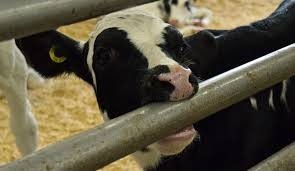Written by Grace Kline
One of the most frustrating things I have dealt with in calf raising is being able to see a problem, but not be able to pin it down. For example, if you see a calf with a cough and a runny nose, we can easily assume she is coming down with pneumonia. However, I’m talking about a calf (or maybe a small group of calves) that are a little too quiet. These calves seem to be just surviving, not thriving. I like my calves to be aggressive and excited to see me when I walk past their hutches, so I find it alarming when I have a calf or two that couldn’t care less about my presence. This, among many other symptoms, can be due to a mineral deficiency. Before taking action, consult your vet to properly diagnose a mineral deficiency and receive the best supplements and dosage recommendations.
A story that I can share from personal experience is of an iron deficiency. When I was working on a New York dairy, we fell into what I can only describe as a death spell. The “death spell” did not discriminate between calving location, breed, or sex. The scenario would be as follows: a cow calves with a seemingly healthy calf. The cow produced a good amount of colostrum, and the calf drank the colostrum well. 12 hours later, the calf would seem lazy. 24 hours later, the calf could not stand or hold their own head up. They would wind up dead around 48 hours.
So, what went wrong?
We called the vet to bring bacteria swabs and swabbed everything. Anything that the cow, calf, or milk touched or came close to, we checked. Doing this allowed us to find areas to improve on, however it did not solve the issue. We completed 3 separate necropsies, all inconclusive. Tissue samples and test, somehow inconclusive. We heard of another farmer in the area struggling with anemic cows and thought, “what do we have to lose?” The next calf to be born, we administered a subcutaneous mineral injection and an intramuscular iron injection. This calf was the first one to be thriving at 24 hours since the beginning of our “death spell”. We had an iron deficiency, causing our calves to be weak, lazy, and anemic. Not every deficiency will look the same, but this is what we were faced with in a lack of iron.
White muscle disease can be caused by a lack of selenium, vitamin E, or a combination of the two. White muscle disease can affect both the cardiac muscles and the skeletal muscles (The Cattle Site, 2022). Early onset white muscle disease will cause scarring of the cardiac muscles making it impossible to survive. Calves with late onset white muscle disease will show symptoms such as laziness, stiffness, and struggling to move around or eat.
Calves that are deficient in manganese show a general unthriftiness, slow growth rate, and can have swollen joints. A manganese deficiency that is left untreated can cause reproductive harm in the future. Symptoms in older cattle include cystic ovaries, abortions, and weak/deformed calves.
Copper deficiencies can cause cattle to lose their color, which is especially noticeable around their eyes. Copper is especially helpful for white blood cell and immune function, as well as bone growth (Torres, 2022).

As you have probably noticed, the symptoms for each of these deficiencies are fairly similar- low growth rate, laziness, and low appetite. There are also plenty of other minerals than the ones listed above that are important, including calcium and phosphorous for bone growth and support. Other symptoms can include licking/eating dirt or other objects. It is normal for calves to play with things in their mouths, but it is not normal for them to become obsessed with eating a dish or part of their pen.
You will notice dents and scratches in their pens or buckets if they try to fulfill a deficiency on their own. Calves that are deficient will generally have dull eyes and a rough hair coat. Hair coats in calves should be full and flat, not spotty and standing on end. Working with your vet, you will be able to distinguish between any deficiency symptoms and disease symptoms.
A specific mineral deficiency can be tough to pinpoint. Deficiencies can be detected through blood and tissue samples; however, some may require samples from a necropsy after the animal has died. Your vet may recommend a well-rounded mineral supplement to touch on each of these areas. Some supplements can be added to a newborn calf protocol. Paying attention to your calves and fresh cows will help you identify patterns and enable you to give your vet the best information you can.
Grace Kline operates Diamond Valley Dairy in Southeast Pennsylvania with her husband Jacob, along with two of his brothers. They milk 60 cows in a tie stall, where Grace cares for the calves and young stock. Grace graduated from Morrisville State College in Morrisville, New York, after completing an internship on a dairy in Wisconsin where she learned many of her calf care skills.
Dairy-Cattle. “Appropriate Methods of Diagnosing Mineral Deficiencies in Cattle.”DAIReXNET, 16 Aug. 2019, dairy-cattle.extension.org/appropriate-methods-of-diagnosing-mineral-deficiencies-in-cattl e/.
Torres, Hannah. “Common Mineral Deficiencies in Cattle and Treatments – Provico Rural.” ProviCo, 14 Feb. 2022,www.provicorural.com.au/common-mineral-deficiencies-in-cattle-and-treatments/.
“White Muscle Disease.” White Muscle Disease | The Cattle Site, The Cattle Site, 29 Sept. 2022, www.thecattlesite.com/diseaseinfo/258/white-muscle-disease.
